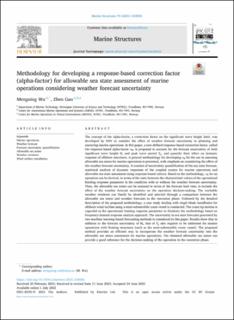| dc.contributor.author | Wu, Mengning | |
| dc.contributor.author | Gao, Zhen | |
| dc.date.accessioned | 2022-04-01T11:32:02Z | |
| dc.date.available | 2022-04-01T11:32:02Z | |
| dc.date.created | 2021-10-17T21:42:08Z | |
| dc.date.issued | 2021 | |
| dc.identifier.citation | Marine Structures. 2021, 79 (103050), . | en_US |
| dc.identifier.issn | 0951-8339 | |
| dc.identifier.uri | https://hdl.handle.net/11250/2989262 | |
| dc.description.abstract | The concept of the alpha-factor, a correction factor on the significant wave height limit, was developed by DNV to consider the effect of weather forecast uncertainty in planning and executing marine operations. In this paper, a new defined response-based correction factor, called the response-based alpha-factor αR, is proposed to account for the forecast uncertainty of both significant wave height Hs and peak wave period Tp, and quantify their effect on dynamic response of offshore structures. A general methodology for developing αR for the use in assessing allowable sea states for marine operations is presented, with emphasis on considering the effect of the weather forecast uncertainty. It consists of uncertainty quantification of the sea state forecast, statistical analysis of dynamic responses of the coupled system for marine operations and allowable sea state assessment using response-based criteria. Based on the methodology, αR for an operation can be derived, in terms of the ratio between the characteristic values of the operational limiting response parameter in the condition with or without the weather forecast uncertainty. Then, the allowable sea states can be assessed in terms of the forecast lead time, to include the effect of the weather forecast uncertainty on the operation decision-making. The workable weather windows can finally be identified and selected through a comparison between the allowable sea states and weather forecasts in the execution phase. Followed by the detailed description of the proposed methodology, a case study dealing with single blade installation for offshore wind turbine using a semi-submersible crane vessel is conducted. The crane tip motion is regarded as the operational limiting response parameter to illustrate the methodology based on frequency-domain response analysis approach. The uncertainty in sea state forecasts generated by two machine learning-based forecasting methods is considered in this paper. Results show that in addition to the forecast uncertainty of Hs, that of Tp also requires to be addressed for marine operations with floating structures (such as the semi-submersible crane vessel). The proposed method provides an efficient way to incorporate the weather forecast uncertainty into the allowable sea states assessment for marine operations. The obtained allowable sea states can provide a good reference for the decision-making of the operation in the execution phase. | en_US |
| dc.language.iso | eng | en_US |
| dc.publisher | Elsevier | en_US |
| dc.rights | Navngivelse 4.0 Internasjonal | * |
| dc.rights.uri | http://creativecommons.org/licenses/by/4.0/deed.no | * |
| dc.title | Methodology for developing a response-based correction factor (alpha-factor) for allowable sea state assessment of marine operations considering weather forecast uncertainty | en_US |
| dc.type | Peer reviewed | en_US |
| dc.type | Journal article | en_US |
| dc.description.version | publishedVersion | en_US |
| dc.source.pagenumber | 23 | en_US |
| dc.source.volume | 79 | en_US |
| dc.source.journal | Marine Structures | en_US |
| dc.source.issue | 103050 | en_US |
| dc.identifier.doi | 10.1016/j.marstruc.2021.103050 | |
| dc.identifier.cristin | 1946518 | |
| dc.relation.project | Norges forskningsråd: 223254 | en_US |
| dc.relation.project | Norges forskningsråd: 237929 | en_US |
| cristin.ispublished | true | |
| cristin.fulltext | postprint | |
| cristin.qualitycode | 2 | |

